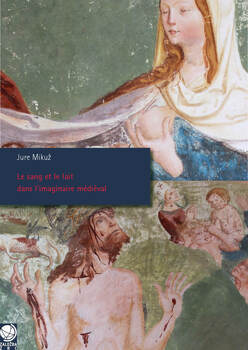Le sang et le lait dans l’imaginaire médiéval
Kužna podoba (tudi Slika nadlog, Mater omnium, Marija zavetnica s plaščem, Marija (po)srednica, Dvojno posredništvo, Kombinirana intercesija, Marija priprošnjica, etc.) v cerkvi Sv. Primoža v Črni pri Kamniku v Sloveniji, ki je nastala leta 1504, ob koncu srednjega veka in na pragu renesanse v osrednji Evropi, dobro odraža prehod med dvema domišljijskima svetovoma in njunima likovnima izrazoma. Trikotna kompozicija, na vrhu je Bog Oče, univerzalna entiteta, spodaj levo Kristus, ki kaže rane (Mož bolečin, Imago pietatis), desno Marija z razgaljenimi prsmi, določa vernikovo dojemanje. Odseva rojstvo, ki ga simbolizira dobrota Marijinega mleka, in smrt, ki jo simbolizirata krutost prelite Kristusove krvi ter grozeči Očetov meč. Postavi Kristusa in Marije sta bili zasnovani kot duhovni, kot podobi skrivnosti evharistije in utelešenja. Besedilo se sprašuje, do kakšne mere je vernik tistega časa v svoji domišljiji povezoval Kristusovo goloto in Marijine prsi s telesnimi deli navadnega človeka. Njuna prikrita erotika je zaznamovala sugestivno podobo, ki je skozi zgodovino spodbujala različne reakcije ...
Blood and Milk in Medieval Imagery
The wall painting Plague Image (also named the Image of Scourge, Mater omnium, The Virgin of Mercy, Our Lady of Protection, Mary the Mediatrix, Double Intercession, Combined Intercession, Our Lady’s Intercession etc.) in the Church of St. Primus in #rna near Kamnik in Slovenia, executed in 1504, at the end of the Middle Ages and at the dawn of the Renaissance in Central Europe, reflects well the passage between the two worlds of imagination and their visual representation. The triangular composition – with God the Father, the universal entity, at its apex, and lower with Christ exposing his wounds (Man of Sorrows, Imago pietatis) on the left, and Virgin Mary on the right, with her bosom bare – determines the believer’s perception. The scene combines the notions of birth, symbolized by the charity of Mary offering her milk, and death, symbolized by the cruelty of blood shed by Christ and the menacing sword of God the Father. At the time of their realization, the figures of Christ and Mary were meant to be spiritual, imaging the mysteries of the Eucharist and the Incarnation. The present text examines the question as to what extent the believers of the past connected, in their imagination, Christ’s nakedness and Mary’s bosom with parts of the body of a common human. The masked eroticism of the two figures put a stamp on this suggestive image which in the course of history provoced various reactions...
Le sang et le lait dans l'imaginaire médiéval
La fresque de L’image de la peste (aussi L’image des fléaux, La Vierge de miséricorde, La Vierge au manteau, La Vierge protectrice (ou tutélaire), La Vierge médiatrice, intercédant pour le salut des hommes, La Vierge avocate, La Double intercession, L’Intercession combinée etc.) de l’église de Saint Prime à Črna près de Kamnik en Slovénie, qui a été réalisée en 1504, à la fin du Moyen Âge et au seuil de la Renaissance dans l’Europe centrale, reflète le passage entre deux mondes et leurs représentations. Le triangle, tel qu’il y est composé, avec, en haut, Dieu, entité universelle, et, en bas, des deux côtés, le Christ montrant ses plaies (L’Homme de douleurs, vir dolorum, imago pietatis) et Marie ses seins nus, détermine la perception du croyant. Il englobe la naissance, symbolisée par la bonté, à rapporter au lait marial, et la mort, symbolisée par la cruauté, à rapporter au sang du Christ et à l’épée dégainée de Dieu le Père. À l’époque de leur réalisation, les figures du Christ et de Marie étaient conçues comme spirituelles, pleines du mystère de l’Eucharistie et de l’Incarnation. Mais la question se pose de savoir dans quelle mesure le spectateur d’hier était tenté de rapprocher la nudité du Christ et des seins de Marie de celle des parties du corps humain réel ? Leur érotisme déguisé marque une image qui provoquait les réactions...
Prenosi

Licenca

To delo je licencirano pod Creative Commons Priznanje avtorstva-Nekomercialno-Brez predelav 4.0 mednarodno licenco.
